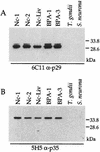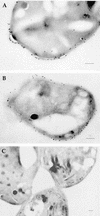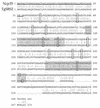The p29 and p35 immunodominant antigens of Neospora caninum tachyzoites are homologous to the family of surface antigens of Toxoplasma gondii
- PMID: 9784539
- PMCID: PMC108665
- DOI: 10.1128/IAI.66.11.5322-5328.1998
The p29 and p35 immunodominant antigens of Neospora caninum tachyzoites are homologous to the family of surface antigens of Toxoplasma gondii
Abstract
Neospora caninum is an apicomplexan parasite that is closely related to Toxoplasma gondii and has been found to be associated with neurological disorders in dogs and congenital infections and abortions in cattle. We have identified two surface proteins of 29 and 35 kDa (designated Ncp29 and Ncp35, respectively) from N. caninum tachyzoites that are the predominant antigens recognized by antisera from Neospora-infected animals. Monoclonal antibodies against Ncp29 and Ncp35 were used to analyze several independent and diverse N. caninum isolates; both antigens were recognized in all isolates, suggesting that they are well conserved. Localization studies and surface labeling with biotin demonstrated that Ncp29 and Ncp35 are membrane associated and displayed on the surface of the parasite. After treatment with phosphatidylinositol-specific phospholipase C, parasite lysates were analyzed with antibodies against the cross-reacting determinant of glycosylphosphatidylinositol anchors. Approximately six glycolipid-anchored surface proteins were identified, with the two most prominent corresponding to Ncp29 and Ncp35. Sequence comparisons of Ncp29 and Ncp35 with GenBank indicated that they are most similar to the T. gondii surface antigen 1 (SAG1) and surface antigen 1-related sequence 2 (SRS2), respectively. Consequently, Ncp29 has been designated NcSAG1 and Ncp35 has been designated NcSRS2. Both NcSAG1 and NcSRS2 contain a tandemly duplicated motif and 12 absolutely conserved cysteines which are also found in all of the SAG and SRS proteins of T. gondii. Maintenance of these motifs and the 12 cysteine residues suggests that these surface antigens share a similar secondary and tertiary structure that is presumably important for a conserved function that these antigens serve during infection.
Figures







References
-
- Ajioka J A, Boothroyd J C, Brunk B P, Hehl A, Hillier L, Manger I D, Overton G C, Marra M, Roos D, Wan K L. Gene discovery by EST sequencing in Toxoplasma gondii reveals sequences restricted to the Apicomplexa. Genome Res. 1998;8:18–28. - PubMed
-
- Altschul S F, Gish W, Miller W, Myers E W, Lipman D J. Basic local alignment search tool. J Mol Biol. 1990;215:403–410. - PubMed
-
- Anderson M L, Blanchard P C, Barr B C, Dubey J P, Hoffman R L, Conrad P A. Neospora-like protozoan infection as a major cause of abortion in California dairy cattle. J Am Vet Med Assoc. 1991;198:241–244. - PubMed
-
- Asai, T., D. K. Howe, K. Nakajima, T. Nozaki, T. Takeuchi, and L. D. Sibley. Neospora caninum: tachyzoites express a potent type-I nucleoside triphosphate hydrolase, but lack nucleoside diphosphate hydrolase activity. Exp. Parasitol., in press. - PubMed
Publication types
MeSH terms
Substances
Associated data
- Actions
- Actions
LinkOut - more resources
Full Text Sources
Other Literature Sources
Research Materials

